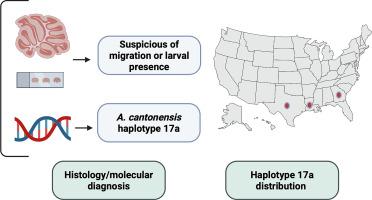Angiostrongylus cantonensis infection in a captive non-human primate (Varecia variegata) from the southeastern United States
IF 1.4
Q3 PARASITOLOGY
Veterinary parasitology, regional studies and reports
Pub Date : 2025-09-01
DOI:10.1016/j.vprsr.2025.101337
引用次数: 0
Abstract
Angiostrongylus cantonensis is a nematode of public health relevance that parasitizes lungs of rodents and can cause eosinophilic meningoencephalitis in humans. In this study we report a case of meningoencephalitis due to A. cantonensis infection in a geriatric, male black-and-white ruffed lemur (Varecia variegata) at a zoological facility in Atlanta, Georgia, southeastern United States of America. In December 2022, the animal presented with a history of acute hindlimb lameness that progressed to right hindlimb paresis and paralysis with loss of pain sensation. Radiographs revealed possible decrease in intervertebral joint space and spondylosis deformans at vertebrae C7-T1, T8-T10, and Cd 2–4. Euthanasia was elected due to the poor prognosis of the intervertebral disease. To investigate potential additional causes for the neurological manifestation exhibited by the animal, fragments of organs and tissues (i.e., eye, spinal cord, peripheral nerves, and brain) were fixed in 10 % neutral buffered formalin and processed and embedded in paraffin. Hematoxylin and eosin-stained slides were assessed for histological changes. Scrolls of the cerebellum were also processed for genomic DNA extraction followed by PCR and sequencing. The histological evaluation revealed lesions compatible with migration or presence of larval nematodes in nervous and ocular tissues. The parasitism by A. cantonensis was molecularly confirmed (GenBank: PQ783804) in cerebellum samples, supporting the evidence of the infection in a non-human primate kept in the Atlanta Zoo, Georgia. While the lemur had intervertebral disease that could have caused neurological manifestations, the presence of A. cantonensis could have contribute to the overall clinical presentation.

美国东南部圈养非人灵长类动物(vararecia variegata)的广州管圆线虫感染
广东管圆线虫是一种与公共卫生相关的线虫,寄生于啮齿动物的肺部,并可引起人类嗜酸性脑膜脑炎。在这项研究中,我们报告了一例在美国东南部乔治亚州亚特兰大市的一个动物设施中,由广东亚种感染引起的老年雄性黑白皱褶狐猴(Varecia variegata)脑膜脑炎。2022年12月,该动物出现急性后肢跛行史,随后发展为右后肢麻痹和瘫痪,并丧失疼痛感觉。x线片显示椎间关节间隙可能缩小,C7-T1、T8-T10和cd2 - 4椎体出现脊柱变形。由于椎间病变预后不佳,选择安乐死。为了调查动物表现出的神经系统表现的潜在其他原因,将器官和组织(即眼睛,脊髓,周围神经和大脑)的碎片固定在10%中性缓冲福尔马林中,然后处理并包埋在石蜡中。苏木精染色和伊红染色切片检查组织学变化。小脑卷轴也进行基因组DNA提取,然后进行PCR和测序。组织学评估显示病变与神经和眼部组织中幼虫线虫的迁移或存在相一致。在小脑样本中证实了广东按蚊的寄生(GenBank: PQ783804),支持了在佐治亚州亚特兰大动物园饲养的一种非人灵长类动物中感染的证据。虽然狐猴患有可能引起神经系统症状的椎间疾病,但广东猿猴的存在可能有助于整体临床表现。
本文章由计算机程序翻译,如有差异,请以英文原文为准。
求助全文
约1分钟内获得全文
求助全文
来源期刊
CiteScore
2.90
自引率
7.10%
发文量
126
审稿时长
97 days
期刊介绍:
Veterinary Parasitology: Regional Studies and Reports focuses on aspects of veterinary parasitology that are of regional concern, which is especially important in this era of climate change and the rapid and often unconstrained travel of people and animals. Relative to regions, this journal will accept papers of the highest quality dealing with all aspects of disease prevention, pathology, treatment, epidemiology, and control of parasites within the field of veterinary medicine. Also, case reports will be considered as they add to information related to local disease and its control; such papers must be concise and represent appropriate medical intervention. Papers on veterinary parasitology from wildlife species are acceptable, but only if they relate to the practice of veterinary medicine. Studies on vector-borne bacterial and viral agents are suitable, but only if the paper deals with vector transmission of these organisms to domesticated animals. Studies dealing with parasite control by means of natural products, both in vivo and in vitro, are more suited for one of the many journals that now specialize in papers of this type. However, due to the regional nature of much of this research, submissions may be considered based upon a case being made by the author(s) to the Editor. Circumstances relating to animal experimentation must meet the International Guiding Principles for Biomedical Research Involving Animals as issued by the Council for International Organizations of Medical Sciences (obtainable from: Executive Secretary C.I.O.M.S., c/o W.H.O., Via Appia, CH-1211 Geneva 27, Switzerland).

 求助内容:
求助内容: 应助结果提醒方式:
应助结果提醒方式:


